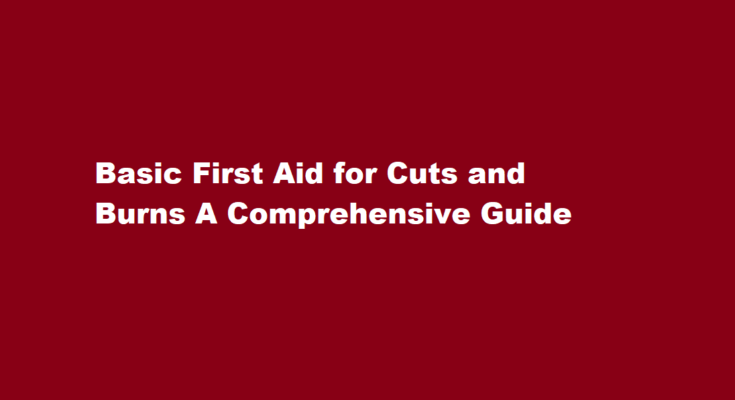Introduction
Accidents happen, and knowing how to provide basic first aid for cuts and burns can be invaluable in preventing infection, minimizing pain, and promoting faster healing. Whether it’s a minor cut from a kitchen mishap or a small burn from touching a hot surface, immediate and appropriate care can make a significant difference in the outcome. In this article, we will explore step-by-step procedures to handle cuts and burns effectively, ensuring safety and promoting recovery.
Cuts – Quick and Effective Care
Assess the Severity
Before anything else, evaluate the cut’s depth and length. Minor cuts can often be treated at home, while deep or severe cuts require professional medical attention.
Clean Your Hands
Always wash your hands thoroughly with soap and water before touching the wound to prevent infection.
Control Bleeding
If the cut is bleeding, apply gentle pressure using a clean cloth or sterile gauze pad. Elevate the injured area above heart level to help reduce blood flow.
Clean the Wound
Rinse the cut with clean, running water to remove dirt and debris. Avoid using hydrogen peroxide or alcohol as they can damage healthy tissues.
Apply an Antiseptic
After cleaning, apply an over-the-counter antiseptic solution to the wound to further reduce the risk of infection.
Use a Bandage or Dressing
For small cuts, apply a sterile adhesive bandage or dressing to protect the wound from further contamination. Change the dressing regularly.
Observe for Infection
Keep an eye on the wound for any signs of infection, such as increasing redness, swelling, pus, or warmth. If these symptoms develop, seek medical attention.
Burns – Soothing Relief and Proper Care
Assess the Burn Severity
Determine whether the burn is minor or requires medical attention. First-degree burns (superficial) usually appear red and painful, while second-degree burns (blistering) are deeper and more severe.
Cool the Burn
For minor burns, immediately run cool (not cold) water over the affected area for about 10-20 minutes. This helps to reduce pain and prevents the burn from worsening.
Do Not Pop Blisters
If blisters have formed, refrain from popping them, as it increases the risk of infection.
Avoid Ice or Butter
Do not use ice, butter, or any greasy substance on burns, as they can cause further damage to the skin and hinder healing.
Cover the Burn
Once the burn has been cooled, cover it with a clean, non-stick bandage or sterile gauze to protect it from infection.
Use Pain Relief
Over-the-counter pain relievers like ibuprofen or acetaminophen can help manage pain and reduce inflammation.
Seek Medical Attention
If the burn is severe, covers a large area, or affects sensitive areas like the face, hands, feet, or genitals, seek immediate medical attention.
FREQUENTLY ASKED QUESTIONS
What is the first aid for cuts and burns?
Step 1: Rinse the burn with cool water.
Step 2: Apply a thin layer of antibiotic ointment to the wound.
Step 3: Cover the burn with loose, clean gauze. Conversely, you should never put ice, butter or any ointment other than an antibiotic, on a burn.
What is a basic first aid?
First aid can include cleaning minor cuts, scrapes, or scratches; treating a minor burn; applying bandages and dressings; the use of non-prescription medicine; draining blisters; removing debris from the eyes; massage; and drinking fluids to relieve heat stress.
Conclusion
Knowing how to administer basic first aid for cuts and burns is essential for everyone, as accidents can occur at any time. By following these simple steps, you can provide quick and effective care for minor cuts and burns, ensuring proper healing and reducing the risk of infection. Remember that for severe cuts or burns, or if you’re unsure about how to handle the injury, it’s always best to seek professional medical help promptly.
Furthermore, prevention is key in avoiding such accidents altogether. Keep your living and working areas organized and free from hazards. Use appropriate safety gear, such as gloves and goggles when necessary. Educate yourself and your family on basic first aid techniques, and consider taking a certified first aid course to gain more in-depth knowledge and confidence in handling emergencies.
By being prepared and proactive, you can respond calmly and effectively to cuts and burns, ensuring the best possible outcome for yourself and those around you. Let us all strive to create safer environments and be equipped to handle unexpected situations with care and competence.
Read Also : Mastering Your Finances Crafting a Monthly Budget to Thrive Financially



